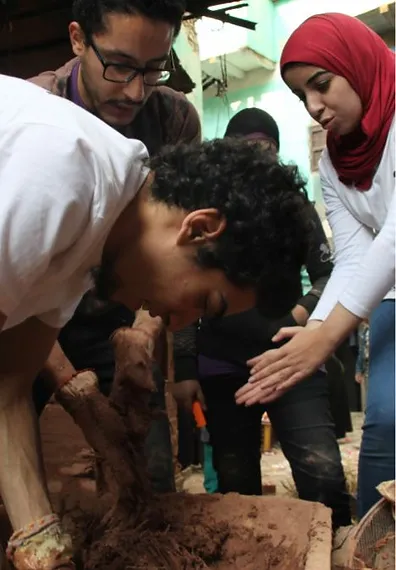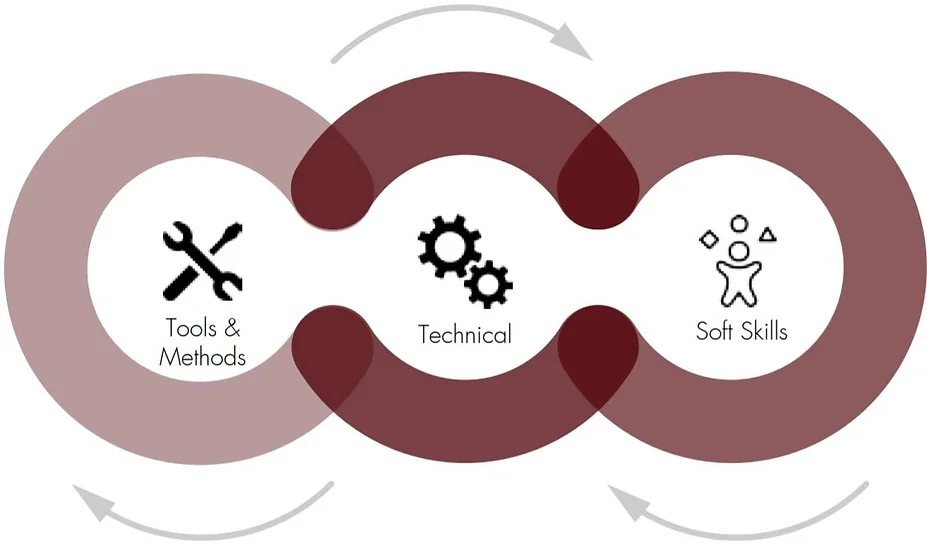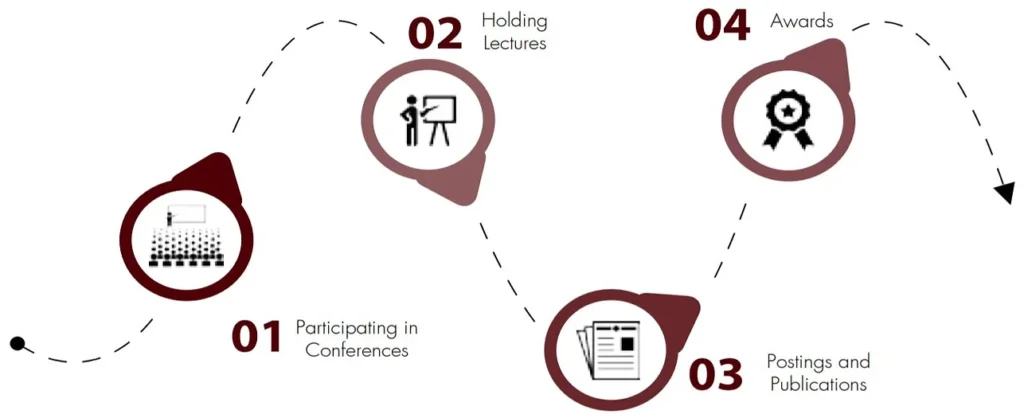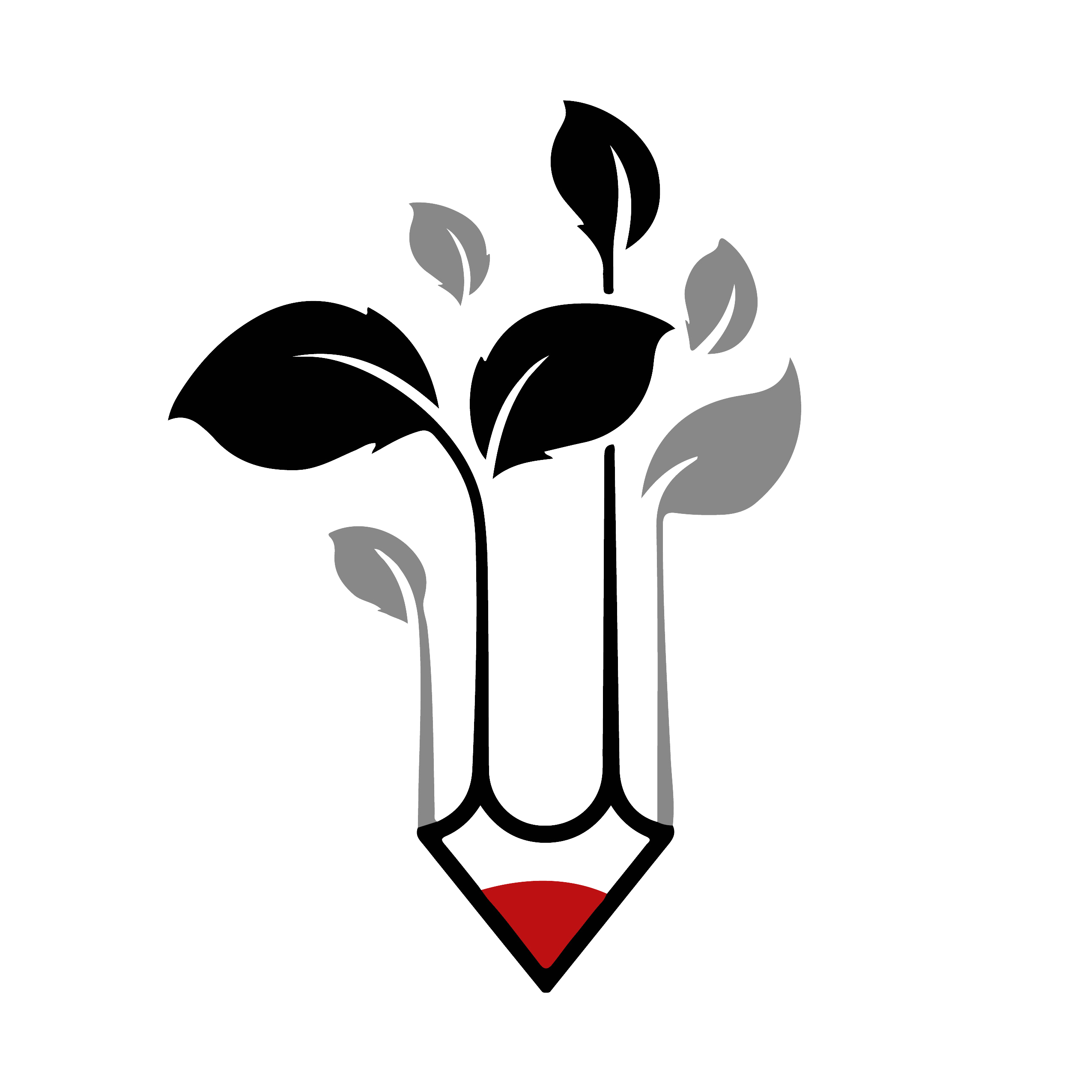
Efforts were put to mediate the flow of knowledge and the expertise on two levels: internally, the flow of expertise from experts to the project team and to Ezbet Community, and externally, the flow of information from the project to the public. Internally, our efforts were directed to training our team leaders, team members, our participating students, as well as the participating community members. That was achieved through the following:
TOOLS AND METHODS
In order to facilitate our team and participating students’ data gathering and analysis, extensive trainings were planned and delivered to them by experts in several useful tools (GIS, SPSS, Grounded Theory, etc.)
TECHNICAL TRAINING
The project was not limited to the research and design part of the work, but the execution as well. For that to happen in the most convenient ways possible: regular trainings were delivered to our site engineering team, to our junior experts’ team, as well as to a number of participating community members. These trainings were hands on and included immediate trials and execution. They included experimental work such as testing the properties of eco-friendly construction materials, and more practical work such as the complete process of building using mudbricks, starting from the making of the mud-bricks, missing the mortar, and building with it. Some of these training required commuting outside Cairo to area where the materials are found more abundantly, like in Fayoum.
SOFT SKILLS
Our project takes pride of focusing efforts in investing in building capacity in undergraduate and freshly graduated students. In order for them to lead the work progress, our new hires receive trainings in soft skills such as: management, time-management, communication skills, technical writing, etc. On another hand, we strived for the presentation of our work externally. This was achieved through the following:
1 – Participating in Conferences
We were fortunate to participate in a number of conferences: SPCairo-13 in 2013 where we gave a lecture about the project, presented our community center project, and led a workshop for the students, and most recently in Architecture for Change held at the French Institute in Alexandria.
2 – Holding Lectures
We generally organized a number of lectures, mostly in 2015, where we hosted well-esteemed, international keynote speakers like Anna Herlinger, Martin Rauch, and Prof. Adel Fahmy. Each talked about their field of expertise: Eco-friendly architecture, the technicalities of earth construction and building with rammed earth, building with local materials, and building for the poor
3 – Postings and Publications
An essential part of our outreach was through publishing the progress of our work. Examples of these publications are: the results of our community center competition which were published in 2013 in a French magazine, the regular update of our work in the scientific magazine of the University of Stuttgart, as well as a number of other respected newspapers that discussed the methodologies and techniques of Ezbet Project.
4 – Awards
Ezbet Project was blessed with be acknowledged by the networks of Design-Build-X-change, SEED, and Live Projects Networks for our School Makeover project, our Oven Intervention, and our Street intervention which indeed received the Live Projects honor. These awards were officially announced on the jury’s official platforms.
“Ezbet” Project has been evaluated in 2016 for its work on the ground and one of its live project. For this it t has been awarded and received an Honorable Mention from the Social Environmental Economic Design (SEED) + design-build-X-change + Live Projects Network Awards 2017 for its intervention «Street Upgrading – Physical Intervention based on a Participatory Needs Assessment (PNA)» on the 26th of January 2017.
Jury Comments
“An excellent example of careful academic research and participatory expertise being applied to initiate positive change in the complex urban context of an informal area of Cairo where poverty and a lack of infrastructure have such a negative impact on the lives, health and economic prospects of local people. A participatory approach was taken to assess the needs and harness the capacity of the community before strategies were decided and action taken. This included participatory strategies being used to connect and share the expertise of such a diverse team of collaborators and experts. The overall quality, sustainability and function of the urban space were considered in order to maximise the benefits of intervention.”
INTERNAL EFFORTS

EXTERNAL EFFORTS

STREET UPGRADE (Cairo, Egypt) – 2016
From about five intersections within the dense urban fabric of Ezbet Abu Qarn in Cairo, a narrow street in the heart of the area was chosen to be redesigned as a public space. The project’s aim was to create public space awareness among the inhabitants, alter the urban experience to match that of old Islamic Cairo, and introduce new ideas to the locals through using recycled materials. This project was about the collaboration of the community with the academia. Integrated teams from both sides of the stakeholders developed and implemented designs that fulfilled the needs of the users of the selected zone. The urban space intervention included:
- Modifying an arched gateway to the enclosed parts of EZBET.
- Renewing the wall design and introducing different finishing materials.
- Installing a floor pattern with recycled tiles.
- Inserting built-in seats with recycled bricks.
- Renovating the old chickens’ nest with clay bottles instead of typical.
- Adding flower boxes to signify the importance of greenery in public spaces.
Out of the three pillars of EZBET sustainable development; Heath, Education & Profession, the project addressed: Education by introducing new materials and the process of implementation, as well as health by improving the build environment and raising hygienic level.
Client:
– Residents of Ezbet Abu Qarn Tutors: Dr. Manal ElShahat (Stuttgart), Dr. Sami Afifi (ASU), Dr. Mohamed El Fayoumi (ASU)
– Other Facilitators: Prof. Dr. Adel Fahmy, Ahmed AbdelWahab, Zeiad Amer, Helena Bartle, Corinna Mölkner, Islabell Enssle, Fady Magdy, Mahmoud ELSalamouny, Maha Attia, Mohab Essam, Barihan Amr, Sandra Samy, Hussein Mohamed, Nahla Hassan, Amr Yousef
Research Question:
Ezbet Abu Qarn is one of the informal areas in the heart of old Cairo. It is located behind Amr Ibn-Al-As Mosque, the oldest mosque in Africa. Like so many informal areas around the world, this neighbourhood has to deal with profound problems: such as poverty, lack of infrastructure, unpaved streets, and very poor and unhygienic conditions. Through successive observations, it was pointed out that their daily lifestyle, especially within the core of the residential area, is characterized by women sitting together with their children during the day in front of their houses communicating with other families and neighbors. This is an example of how such communities utilize their urban spaces. Research Approach: The project targeted the following two main research approaches that reflected the participatory process based on the needs assessment of the community:
- Develop flexible designs that can be adjusted and later on managed by the community to improve the quality and the function of the urban space.
- Define technical tools used in the process of achieving the highest level of community engagement and involvement in all phases of the implementation.
EARTHEN OVEN PROJECT (Cairo, Egypt) – 2015
From a survey conducted in June 2015, it turned out that %10 of the community owned indoor ovens. However, these ovens didn’t usually last long as they fell apart either because of excessive usage or weather conditions. Students with tutors developed designs and tested materials for the construction of a community oven using traditional earth construction methods. A site was chosen based on research in order to create a hub for meeting, cooking and social interaction. On-site discussions with the local community gave a much greater understanding of the impact of the project. After construction it was noted that around 6 different families use the oven for cooking, additionally it is used as a place to sell produce.
Client:
-Local Community and Families with Poor Cooking Facilities
-Tutors: Dr. Manal El Shahat, Dr. Sami Afifi, Dr. Mohamed El Fayoumi, Paulo Carneiro, Alina Jeronimo
Other Facilitators:
Barihan Amr (Urban Planning and Design, Ain Shams University), Mohab Essam (Architecture, Cairo University), Islam Abu Al-Dardaa’ (Architecture, MSA Uni), Petro Oberacher (Social Researcher, Austria), Sandra Sami (Social Researcher, University) Students: Ibrahim Moussa (Architecture, Cairo University), Mohamed Abbas (Architecture, MSA University), Merna Reda (Landscape Architecture, Ain Shams University), Mostafa Fahmy (Landscape Architecture, Ain Shams University).
Research Question:
Through studying the origins of the locals and their former lifestyle, we see that they used to take care of their needs by themselves. From growing their own food to building their own houses; they worked together efficiently as a society. We also see that the oven played a vital role in their former lifestyle as it was the mean of producing the most important item of their meals; the bread. People who come from the countryside are strongly tied to their culture and lifestyle, however, living in the big city can weaken such ties. This was the case with the locals of Ezbet Abu Qarn; as generations succeeded generations, they got more detached from their origins and culture. Thus, the choice of the oven was suitable since it represents an object from their past that is rooted deep in their heritage.
